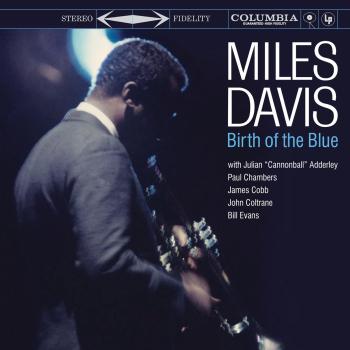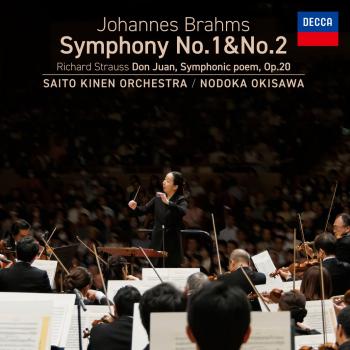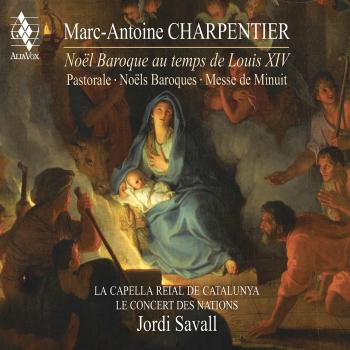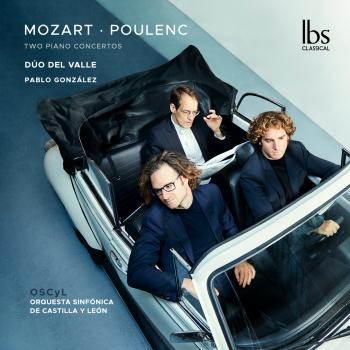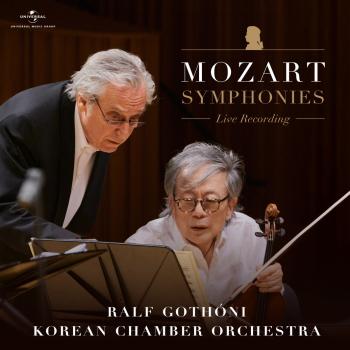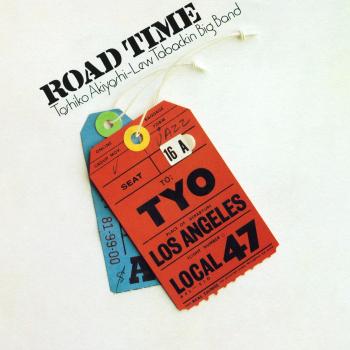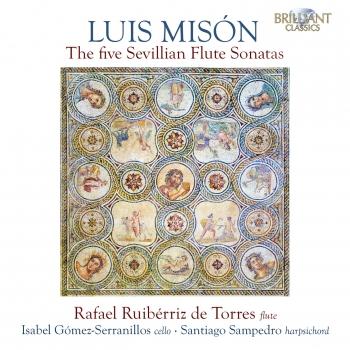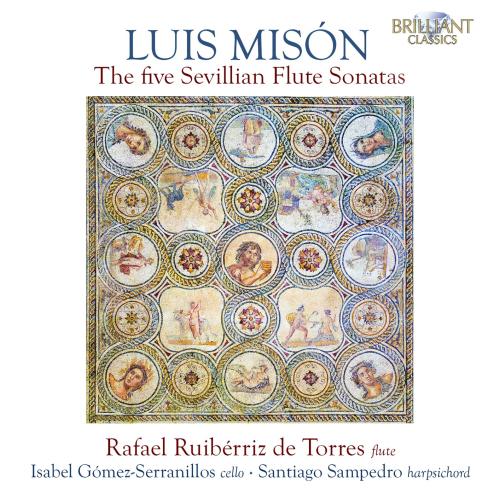
Misón: The Five Sevillian Flute Sonatas Rafael Ruibérriz de Torres Fernandéz, Isabel Goméz-Serranillos, Santiago Sampedro
Album info
Album-Release:
2023
HRA-Release:
30.06.2023
Label: Brilliant Classics
Genre: Classical
Subgenre: Chamber Music
Artist: Rafael Ruibérriz de Torres Fernandéz, Isabel Goméz-Serranillos, Santiago Sampedro
Composer: Luis Mison (1727-1776)
Album including Album cover Booklet (PDF)
- Luis Misón (1727 - 1776): Sonata No. 1 in G Major:
- 1 Misón: Sonata No. 1 in G Major: I. Andantino - Presto - Andantino 02:55
- 2 Misón: Sonata No. 1 in G Major: II. Allegro 04:11
- Sonata No. 2 in G Major:
- 3 Misón: Sonata No. 2 in G Major: I. Presto 02:28
- 4 Misón: Sonata No. 2 in G Major: II. Adagio 04:03
- 5 Misón: Sonata No. 2 in G Major: III. Allegro 04:18
- Sonata No. 3 in G Major:
- 6 Misón: Sonata No. 3 in G Major: I. Allegro Moderado 04:36
- 7 Misón: Sonata No. 3 in G Major: II. Adagio 06:23
- 8 Misón: Sonata No. 3 in G Major: III. Presto 05:31
- Sonata No. 4 in G Major:
- 9 Misón: Sonata No. 4 in G Major: I. Andantino 06:55
- 10 Misón: Sonata No. 4 in G Major: II. Adagio 04:29
- 11 Misón: Sonata No. 4 in G Major: III. Allegro 01:50
- Sonata No. 5 in D Major:
- 12 Misón: Sonata No. 5 in D Major: I. (No Tempo Indication) 03:33
- 13 Misón: Sonata No. 5 in D Major: II. (No Tempo Indication) 03:39
- 14 Misón: Sonata No. 5 in D Major: III. Minuete 03:27
Info for Misón: The Five Sevillian Flute Sonatas
Recent scholarship on Luis Misón (Mataró, 1727–Madrid, 1766) demonstrates the growing interest among the musicological community in studying the life and work of one who is an essential composer in the history of Spanish music. Musical historiography has extolled Misón's contribution to the genre of the tonadilla escénica, a genre widely appreciated in his time and which must have had a notable influence on his instrumental music, about which less is known.
His talent as a flautist was appreciated within the noble circle of the House of Alba, where musical academies were held in which Misón actively participated and for which he composed 12 sonatas for transverse flute and bass dedicated to the Duke of Alba. These pieces were located in the archives of the House of Alba and described in 1927 by José Subirá (1882–1980), but unfortunately they disappeared during the Spanish Civil War (1936–39).
The discovery of the five hitherto unknown Sonatas for Flute and Bass by Misón represents a substantial contribution to the Spanish chamber music repertoire of the second third of the 18th century for this instrument, given the scarcity of pieces written by Hispanic composers contemporary to Misón in which the flute is definitely the real protagonist. Moreover, they are sonatas which, from a technical point of view, pose interesting challenges to the flautist, something that highlights Misón's mastery of the flute, in accordance with surviving documentation of the period. Ortega explains that José Teixidor (c.1751–c.1811), vice-master of the Royal Chapel from 1778, considered his works to be no lesser than those of the best-known foreign composers and said of him that he was an unequalled performer on the transverse flute. The sonatas are found in five musical manuscripts preserved in the Lebrija Palace in Seville, a stately home dating from the 16th century, which in 1901 became the property of Regla Manjón y Mergelina (1851–1938), Countess of Lebrija. With regard to the sources, it seems unlikely that any of the five are autograph. (Although up to five different copyists have been identified, there is nothing to suggest that any of them could be Misón, himself.) Generally speaking, the sonatas are characterised by the importance of melody, regular phrases and steady rhythms, as can be seen in the elaborate seisillos of the Allegro moderato of the Sonata [No.3] in G major. Overall, the basso continuo line is simple – excepting the B section of the Allegro of the Sonata [No.4] in G major (undated) – allowing the role of the flute to stand out prominently.
This recording is the culmination of a long process of recovery of Spanish 18th-century musical heritage that deserves to be disseminated, studied and enhanced. After more than two centuries of silence, Misón's music is heard again.
Rafael Ruiberriz de Torres, flute
Isabel Gomez-Serranillos, cello
Santiago Sampedro, harpsichord
Rafael Ruibérriz de Torres Fernandéz
A disciple of Wilbert Hazelzet, Rafael Ruibérriz de Torres (b. Seville, 1983) first came into contact with music as a chorister in the Seville Cathedral. He studied flute at the Seville Conservatory, where he was awarded the prestigious end-ofcourse prize. Given a grant by the Consejería de Cultura of the Junta de Andalucía, he went on to specialise in early flutes at the Royal Conservatory of The Hague with Wilbert Hazelzet. He also studied at the Royal College of Music in London with Lisa Beznosiuk. He has worked with conductors such as Michael Thomas, Daniel Barenboim, Giovanni Antonini, Jos van Immerseel, Martin Gester, Jean-Claude Malgoire, Gustav Leonhardt, Mark Minkowski, Christophe Rousset, Louis Langrée, Philippe Herreweghe, Mark Elder, Christophe Coin, Robert Levin, Enrico Onofri, Roger Norrington, Hervé Niquet and Alan Curtis, among others. He was principal flute in The Wallfisch Band and continues to play regularly with the Orquesta Barroca de Sevilla, but is primarily active in the world of 18th-, 19th- and 20th-century chamber music. For Brilliant Classics he has recorded the complete quintets for flute and string quartet by Boccherini with the Francisco de Goya string quartet, as well as the 1840 version by Francisco Asenjo Barbieri of Haydn’s Seven Last Words of Christ for flute and string quartet with the La Spagna ensemble, and The five Sevillian Flute Sonatas by Luis Misón. He has recently recorded C.P.E. Bach’s D minor flute concerto with the Orquesta Barroca de Sevilla and the unpublished C.F. Abel E minor Flute Concerto (AbelWV F14) with La Spagna.
Isabel Gomez-Serranillos
Born in Seville, where he began his cello studies with Manuel Tomillo at the Cristóbal de Morales Professional Conservatory. He took advanced courses with Leonardo Luckert, Dirk Vanyhuse, Álvaro Campos, Nonna Natsvlishvili, Gretchen Talbot and Gregory Bennet. She continued her studies with Ivo Cortés at the Conservatorio Superior de Música de Sevilla.
Interested in the world of early music, she began studying baroque cello with Manuel Tomillo in Seville and attended courses with specialists such as Barthold Kuijken, François Fernandez, Alonso Salas, Ángel Sampedro, Peter Zajicek, Walter Reiter and Benjamin Chenier. She then moved to Belgium to specialise in historical cello performance with Alain Gervreau at the Koninklijk Conservatorium in Brussels.
Specialising in the performance of music on ancient instruments, she is a member of the ensembles El Arte Mvsico, Marizápalos and The New Baroque Times (Belgium). She is also first cello of the Orquesta Barroca Conde Duque.
In 2013 he presented his first recording, as a member of El Arte Mvsico, the world's first recording of the complete VI Sonate a due Violini col suo Basso continuo (Nüremberg, 1694) by the German Philipp Heinrich Erlebach, for the VERSO label.
He has also worked with other groups such as Coro de Cámara de Sevilla, Joven Orquesta Barroca de Andalucía, Archivo 415, Conjunto Vocal e Instrumental Virelay, Ottava Rima, Clave Arcadia, Orquesta Barroca de Granada and Orquesta Barroca Cristóbal de Morales de Sevilla.
Santiago Sampedro
Born in Seville in 1988. He completed his advanced harpsichord studies under the direction of Professor María Nieves Gómez and Alejandro Casal at the Conservatorio Superior de Música Manuel Castillo (Seville) in 2013, with the qualification of Outstanding. He is founder and director of the Santa Cecilia Chamber Group and the Ensemble Santa Cecilia, as well as harpsichordist of the Ensemble Dardanus and the group Le Nouveau Concert. In 2016, he received a scholarship from the Asociación Amigos de la Orquesta Barroca de Sevilla to further his studies abroad. He is currently continuing his training at the Royal Conservatorium Koninklijk in The Hague (Holland), specialising in harpsichord, under the direction of Jacques Ogg, Kris Verhelst, Patryck Ayrton and Sungyun Cho. He has also been taught by Laure Morabito, Olivier Baumont, Pedro Gandía, Alfonso Sebastián, Aarón Zapico, Jorge Jiménez...
Booklet for Misón: The Five Sevillian Flute Sonatas


